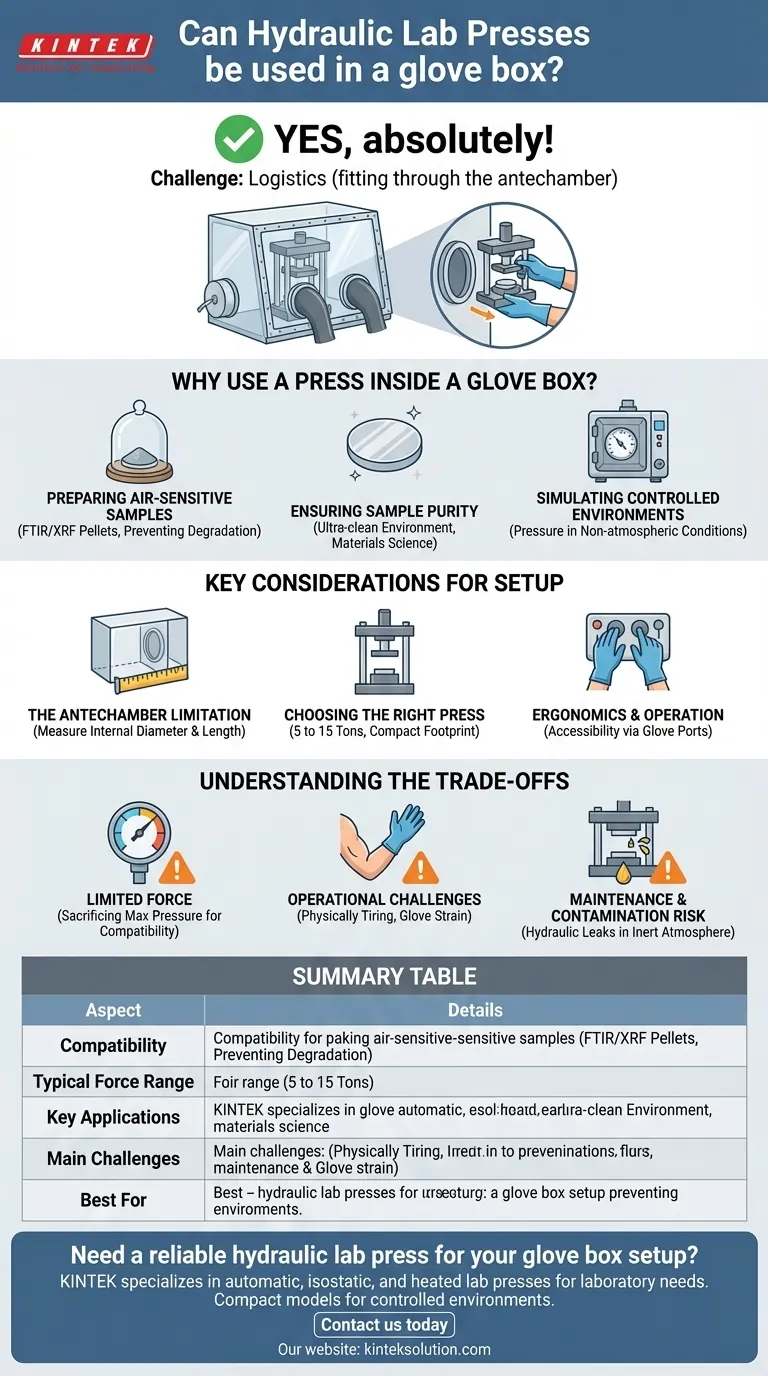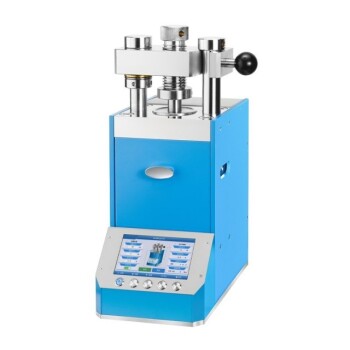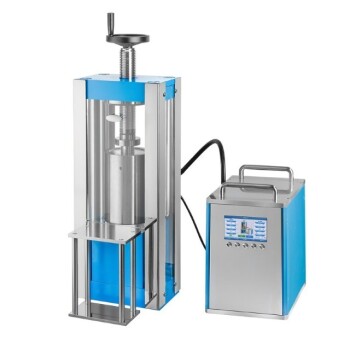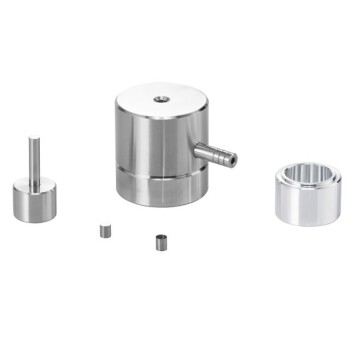Yes, a hydraulic lab press can absolutely be used inside a glove box. The primary challenge is not one of function but of logistics; the press must be small enough to fit through the glove box's antechamber, which is often the most significant limiting factor. For this reason, smaller, compact models are the standard choice for this application.
While it is common practice to use smaller hydraulic presses in glove boxes for preparing air-sensitive samples, success hinges on careful planning. You must verify the press dimensions against your antechamber and consider the ergonomics of operating the equipment through the restrictive glove ports.
Why Use a Press Inside a Glove Box?
Understanding the goal clarifies the requirements. Placing a press in a controlled atmosphere is essential when the sample itself cannot be exposed to ambient air.
Preparing Air-Sensitive Samples
Many advanced materials react with oxygen or moisture in the air. For analytical techniques like FTIR or XRF spectroscopy, samples are often pressed into uniform KBr pellets or thin films. Performing this pressing inside an inert glove box atmosphere prevents sample degradation and ensures accurate analytical results.
Ensuring Sample Purity
Even if a material isn't highly reactive, atmospheric contaminants can deposit on the sample's surface during preparation. A glove box provides an ultra-clean environment, crucial for applications in materials science and semiconductor research where even trace contamination can alter material properties.
Simulating Controlled Environments
In some materials research, the goal is to study how substances behave under pressure in a specific non-atmospheric environment. The glove box provides the controlled atmosphere, while the press supplies the necessary force to simulate conditions like those found in planetary science or specialized industrial processes.
Key Considerations for Your Setup
Successful integration is a matter of measurement and planning. A mistake at this stage can lead to purchasing a press that you cannot use.
The Antechamber Limitation
The antechamber (or "airlock") is the bottleneck. Before considering any press, you must measure the internal diameter and length of your antechamber. These dimensions dictate the absolute maximum size of any equipment you can introduce into the glove box.
Choosing the Right Press
Because of the size constraint, low-tonnage presses (typically 5 to 15 tons) are the most common choice. These models have a smaller footprint and are designed to be more compact than their higher-force counterparts. A 5-ton press is often an excellent starting point as it balances a small size with sufficient force for most pellet-making applications.
Ergonomics and Operation
Consider the physical act of using the press. You will be operating the hydraulic pump handle, placing the die, and reading the pressure gauge through thick, cumbersome gloves. Ensure the press controls are simple, accessible, and visible from your normal working position.
Understanding the Trade-offs
Using a press in a glove box involves compromises. Acknowledging these limitations is key to a successful workflow.
Limited Force
The most significant trade-off is power. The compact presses that fit inside a glove box will not offer the 25+ tons of force available from larger, floor-standing models. You are sacrificing maximum pressure for compatibility with the controlled environment.
Operational Challenges
Pumping a manual hydraulic jack repeatedly through glove ports can be physically tiring and awkward. This can slow down your workflow and, more importantly, increase the strain on the glove box gloves, potentially leading to punctures or tears that compromise the entire atmosphere.
Maintenance and Contamination Risk
A hydraulic leak is a minor annoyance on a lab bench but a major disaster inside a glove box. Hydraulic oil can contaminate the inert atmosphere and every sensitive sample within the enclosure, often requiring a complete and time-consuming teardown and cleaning. Always check for leaks before introducing a press into the box.
Making the Right Choice for Your Research
Your specific application will determine the best path forward. Use your primary goal to guide your selection.
- If your primary focus is routine spectroscopic sample prep (e.g., KBr pellets): A compact, manual 5-ton press is likely your most reliable and cost-effective solution.
- If your primary focus is materials testing requiring higher pressures: Investigate specialized, automated, or custom-built press systems designed specifically for glove box integration, as standard benchtop models may not fit or provide enough force.
- If you are unsure about dimensions: Always choose a press explicitly marketed as "compact" or for "glove box use" and meticulously verify its published dimensions against your antechamber measurements before purchasing.
By carefully matching the equipment to your workspace and research needs, you can successfully integrate hydraulic pressing into your controlled atmosphere workflow.
Summary Table:
| Aspect | Details |
|---|---|
| Compatibility | Yes, with compact models fitting through antechamber |
| Typical Force Range | 5 to 15 tons for most applications |
| Key Applications | Preparing KBr pellets for FTIR/XRF, ensuring sample purity, simulating controlled environments |
| Main Challenges | Size limitations, ergonomic operation, risk of hydraulic leaks |
| Best For | Routine sample prep in inert atmospheres, materials science research |
Need a reliable hydraulic lab press for your glove box setup? KINTEK specializes in automatic lab presses, isostatic presses, and heated lab presses designed for laboratory needs. Our compact models ensure seamless integration into controlled environments, helping you maintain sample purity and achieve precise results. Contact us today to find the perfect press for your research!
Visual Guide

Related Products
- Manual Laboratory Hydraulic Press Lab Pellet Press
- Laboratory Hydraulic Press 2T Lab Pellet Press for KBR FTIR
- Laboratory Hydraulic Press Lab Pellet Press Button Battery Press
- Automatic Laboratory Hydraulic Press for XRF and KBR Pellet Pressing
- Laboratory Hydraulic Press Lab Pellet Press Machine for Glove Box
People Also Ask
- How are hydraulic presses used in the preparation of powder mixtures? Achieve Precise Compaction for Accurate Analysis
- How do you operate a manual hydraulic pellet press? Master Precise Sample Preparation for Accurate Analysis
- What is the primary purpose of a manual lab hydraulic pellet press? Ensure Accurate Sample Prep for XRF and FTIR
- How do hydraulic press machines ensure precision and consistency in pressure application? Achieve Reliable Force Control for Your Lab
- How should a manual hydraulic pellet press be cleaned and maintained? Ensure Accurate Results and Longevity



















